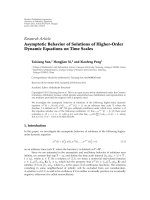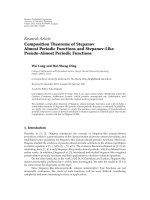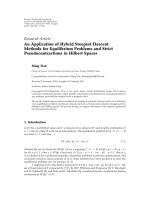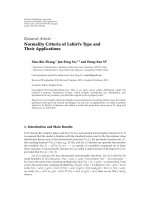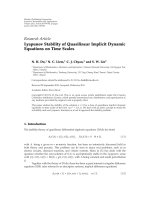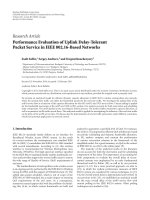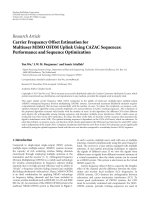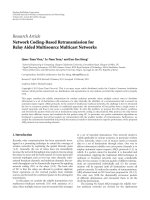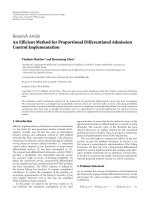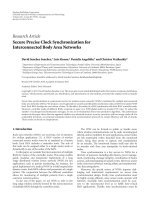báo cáo hóa học:" Research Article Exponential Decay of Energy for Some Nonlinear Hyperbolic Equations with Strong Dissipation Yaojun Ye" ppt
Bạn đang xem bản rút gọn của tài liệu. Xem và tải ngay bản đầy đủ của tài liệu tại đây (497.83 KB, 12 trang )
Hindawi Publishing Corporation
Advances in Difference Equations
Volume 2010, Article ID 357404, 12 pages
doi:10.1155/2010/357404
Research Article
Exponential Decay of Energy for Some Nonlinear
Hyperbolic Equations with Strong Dissipation
Yaojun Ye
Department of Mathematics and Information Science, Zhejiang University of Science and Technology,
Hangzhou 310023, China
Correspondence should be addressed to Yaojun Ye,
Received 14 December 2009; Revised 21 May 2010; Accepted 4 August 2010
Academic Editor: Tocka Diagana
Copyright q 2010 Yaojun Ye. This is an open access article distributed under the Creative
Commons Attribution License, which permits unrestricted use, distribution, and reproduction in
any medium, provided the original work is properly cited.
The initial boundary value problem for a class of hyperbolic equations with strong dissipative
term u
tt
−
n
i1
∂/∂x
i
|∂u/∂x
i
|
p−2
∂u/∂x
i
−aΔu
t
b|u|
r−2
u in a bounded domain is studied. The
existence of global solutions for this problem is proved by constructing a stable set in W
1,p
0
Ω and
showing the exponential decay of the energy of global solutions through the use of an important
lemma of V. Komornik.
1. Introduction
We are concerned with the global solvability and exponential asymptotic stability for the
following hyperbolic equation in a bounded domain:
u
tt
− Δ
p
u − aΔu
t
b
|
u
|
r−2
u, x ∈ Ω,t>0
1.1
with initial conditions
u
x, 0
u
0
x
,u
t
x, 0
u
1
x
,x∈ Ω1.2
and boundary condition
u
x, t
0,x∈ ∂Ω,t≥ 0, 1.3
2 Advances in Difference Equations
where Ω is a bounded domain in R
n
with a smooth boundary ∂Ω, a, b > 0andr, p > 2are
real numbers, and Δ
p
n
i1
∂/∂x
i
|∂/∂x
i
|
p−2
∂/∂x
i
is a divergence operator degenerate
Laplace operator with p>2, which is called a p-Laplace operator.
Equations of type 1.1 are used to describe longitudinal motion in viscoelasticity
mechanics and can also be seen as field equations governing the longitudinal motion of a
viscoelastic configuration obeying the nonlinear Voight model 1–4.
For b 0, it is well known that the damping term assures global existence and decay
of the solution energy for arbitrary initial data 4–6. For a 0, the source term causes finite
time blow up of solutions with negative initial energy if r>p7.
In 8–10, Yang studied the problem 1.1–1.3 and obtained global existence results
under the growth assumptions on the nonlinear terms and initial data. These global existence
results have been improved by Liu and Zhao 11 by using a new method. As for the
nonexistence of global solutions, Yang 12 obtained the blow up properties for the problem
1.1–1.3 with the following restriction on the initial energy E0 < min{−rk
1
pk
2
/r −
p
1/δ
, −1}, where r>pand k
1
,k
2
,andδ are some positive constants.
Because the p-Laplace operator Δ
p
is nonlinear operator, the reasoning of proof and
computation are greatly different from the Laplace operator Δ
n
i1
∂
2
/∂x
2
i
. By means
of the Galerkin method and compactness criteria and a difference inequality introduced by
Nakao 13,Ye14, 15 has proved the existence and decay estimate of global solutions for
the problem 1.1–1.3 with inhomogeneous term fx, t and p ≥ r.
In this paper we are going to investigate the global existence for the problem 1.1–
1.3 by applying the potential well theory introduced by Sattinger 16, and we show
the exponential asymptotic behavior of global solutions through the use of the lemma of
Komornik 17.
We adopt the usual notation and convention. Let W
k,p
Ω denote the Sobolev space
with the norm u
W
k,p
Ω
|α|≤k
D
α
u
p
L
p
Ω
1/p
and W
k,p
0
Ω denote the closure in W
k,p
Ω
of C
∞
0
Ω. For simplicity of notation, hereafter we denote by ·
p
the Lebesgue space L
p
Ω
norm, ·denotes L
2
Ω norm, and write equivalent norm ∇ ·
p
instead of W
1,p
0
Ω
norm ·
W
1,p
0
Ω
. Moreover, M denotes various positive constants depending on the known
constants, and it may be different at each appearance.
2. The Global Existence and Nonexistence
In order t o state and study our main results, we first define the following functionals:
K
u
∇u
p
p
− b
u
r
r
,
J
u
1
p
∇u
p
p
−
b
r
u
r
r
,
2.1
for u ∈ W
1,p
0
Ω. Then we define the stable set H by
H
u ∈ W
1,p
0
Ω
,K
u
> 0,J
u
<d
∪
{
0
}
, 2.2
Advances in Difference Equations 3
where
d inf
sup
λ>0
J
λu
,u∈ W
1,p
0
Ω
/
{
0
}
. 2.3
We denote the total energy associated with 1.1–1.3 by
E
t
1
2
u
t
2
1
p
∇u
p
p
−
b
r
u
r
r
1
2
u
t
2
J
u
2.4
for u ∈ W
1,p
0
Ω, t ≥ 0, and E01/2u
1
2
Ju
0
is the total energy of the initial data.
Definition 2.1. The solution ux, t is called the weak solution of the problem 1.1–1.3 on
Ω × 0,T,ifu ∈ L
∞
0,T; W
1,p
0
Ω and u
t
∈ L
∞
0,T; L
2
Ω satisfy
u
t
,v
−
t
0
Δ
p
u, v
dτ a
∇u, ∇v
b
t
0
|
u
|
r−2
u, v
dτ
u
1
,v
a
∇u
0
, ∇v
2.5
for all v ∈ W
1,p
0
Ω and ux, 0u
0
x in W
1,p
0
Ω, u
t
x, 0u
1
x in L
2
Ω.
We need the following local existence result, which is known as a standard one see
14, 18, 19.
Theorem 2.2. Suppose that 2 <p<r<np/n − p if p<nand 2 <p<r<∞ if n ≤ p.If
u
0
∈ W
1,p
0
Ω,u
1
∈ L
2
Ω, then there exists T>0 such that the problem 1.1–1.3 has a unique
local solution ut in the class
u ∈ L
∞
0,T
; W
1,p
0
Ω
,u
t
∈ L
∞
0,T
; L
2
Ω
. 2.6
For latter applications, we list up some lemmas.
Lemma 2.3 see 20, 21. Let u ∈ W
1,p
0
Ω,thenu ∈ L
q
Ω, and the inequality u
q
≤
Cu
W
1,p
0
Ω
holds with a constant C>0 depending on Ω,p, and q, provided that, i 2 ≤ q<∞ if
2 ≤ n ≤ p and ii 2 ≤ q ≤ np/n − p, 2 <p<n.
Lemma 2.4. Let ut, x be a solution to problem 1.1–1.3.ThenEt is a nonincreasing function
for t>0 and
d
dt
E
t
−a
∇u
t
t
2
.
2.7
Proof. By multiplying 1.1 by u
t
and integrating over Ω,weget
1
2
d
dt
u
t
2
1
p
d
dt
∇u
p
p
−
b
r
d
dt
u
r
r
−a
∇u
t
t
2
,
2.8
4 Advances in Difference Equations
which implies from 2.4 that
d
dt
E
u
t
−a
∇u
t
t
2
≤ 0.
2.9
Therefore, Et is a nonincreasing function on t.
Lemma 2.5. Let u ∈ W
1,p
0
Ω; if the hypotheses in Theorem 2.2 hold, then d>0.
Proof. Since
J
λu
λ
p
p
∇u
p
p
−
bλ
r
r
u
r
r
,
2.10
so, we get
d
dλ
J
λu
λ
p−1
∇u
p
p
− bλ
r−1
u
r
r
.
2.11
Let d/dλJλu0, which implies that
λ
1
b
−1/r−p
u
r
r
∇u
p
p
−1/r−p
.
2.12
As λ λ
1
, an elementary calculation shows that
d
2
dλ
2
J
λu
< 0.
2.13
Hence, we have from Lemma 2.3 that
sup
λ≥0
J
λu
J
λ
1
u
r − p
rp
b
−p/r−p
u
r
∇u
p
−rp/r−p
≥
r − p
rp
bC
r
−p/r−p
> 0.
2.14
We get from the definition of d that d>0.
Lemma 2.6. Let u ∈ H,then
r − p
rp
∇u
p
p
<J
u
.
2.15
Advances in Difference Equations 5
Proof. By the definition of Ku and Ju, we have the following identity:
rJ
u
K
u
r − p
p
∇u
p
p
.
2.16
Since u ∈ H, so we have Ku > 0. Therefore, we obtain from 2.16 that
r − p
rp
∇u
p
p
≤ J
u
.
2.17
In order to prove the existence of global solutions for the problem 1.1-1.3, we need
the following lemma.
Lemma 2.7. Suppose that 2 <p<r<np/n − p if p<nand 2 <p<r<∞ if n ≤ p.If
u
0
∈ H, u
1
∈ L
2
Ω, and E0 <d,thenu ∈ H, for each t ∈ 0,T.
Proof. Assume that there exists a number t
∗
∈ 0,T such that ut ∈ H on 0,t
∗
and ut
∗
/
∈ H.
Then, in virtue of the continuity of ut,weseethatut
∗
∈ ∂H. From the definition of H and
the continuity of Jut and Kut in t, we have either
J
u
t
∗
d, 2.18
or
K
u
t
∗
0. 2.19
It follows from 2.4 that
J
u
t
∗
1
p
∇ut
∗
p
p
−
b
r
ut
∗
r
r
≤ E
t
∗
≤ E
0
<d.
2.20
So, case 2.18 is impossible.
Assume that 2.19 holds, then we get that
d
dλ
J
λu
t
∗
λ
p−1
1 − λ
r−p
∇u
p
p
.
2.21
We obtain from d/dλJλut
∗
0thatλ 1.
Since
d
2
dλ
2
J
λu
t
∗
λ1
−
r − p
∇u
t
∗
p
< 0,
2.22
6 Advances in Difference Equations
consequently, we get from 2.20 that
sup
λ≥0
J
λu
t
∗
J
λu
t
∗
|
λ1
J
u
t
∗
<d,
2.23
which contradicts the definition of d. Therefore, case 2.19 is impossible as well. Thus, we
conclude that ut ∈ H on 0,T.
Theorem 2.8. Assume that 2 <p<r<np/n − p if p<nand 2 <p<r<∞ if n ≤ p. ut
is a local solution of problem 1.1–1.3 on 0,T.Ifu
0
∈ H, u
1
∈ L
2
Ω, and E0 <d, then the
solution ut is a global solution of the problem 1.1–1.3.
Proof. It suffices to show that u
t
2
∇u
p
p
is bounded independently of t.
Under the hypotheses in Theorem 2.8,wegetfromLemma 2.7 that ut ∈ H on
0,T. So formula 2.15 in Lemma 2.6 holds on 0,T. Therefore, we have from 2.15 and
Lemma 2.4 that
1
2
u
t
2
r − p
rp
∇u
p
p
≤
1
2
u
t
2
J
u
E
t
≤ E
0
<d.
2.24
Hence, we get
u
t
2
∇u
p
p
≤ max
2,
rp
r − p
d<∞.
2.25
The above inequality and the continuation principle lead to the global existence of the
solution, that is, T ∞. Thus, the solution ut is a global solution of the problem 1.1–
1.3.
Now we employ the analysis method to discuss the blow-up solutions of the problem
1.1–1.3 in finite time. Our result reads as follows.
Theorem 2.9. Suppose that 2 <p<r<np/n − p if p<nand 2 <p<r<∞ if n ≤ p.If
u
0
∈ H, u
1
∈ L
2
Ω, assume that the initial value is such that
E
0
<Q
0
,
u0
r
>S
0
, 2.26
where
Q
0
r − p
rp
C
pr/p−r
,S
0
C
p/p−r
2.27
with C>0 is a positive Sobolev constant. Then the solution of the problem 1.1–1.3 does not exist
globally in time.
Proof. On the contrary, under the conditions in Theorem 2.9,letux, t be a global solution of
the problem 1.1–1.3; then by Lemma 2.3, it is well known that there exists a constant C>0
depending only on n, p,andr such that u
r
≤ C∇u
p
for all u ∈ W
1,p
0
Ω.
Advances in Difference Equations 7
From the above inequality, we conclude that
∇u
p
p
≥ C
−p
u
p
r
.
2.28
By using 2.28, it follows from the definition of Et that
E
t
1
2
u
t
2
J
u
t
1
2
u
t
2
1
p
∇u
p
p
−
b
r
u
r
r
≥
1
p
∇u
p
p
−
b
r
u
r
r
≥
1
pC
p
u
p
r
−
b
r
u
r
r
.
2.29
Setting
s s
t
u
t
r
Ω
|
u
x, t
|
r
dx
1/r
,
2.30
we denote the right side of 2.29 by QsQut
r
, then
Q
s
1
pC
p
s
p
−
b
r
s
r
,s≥ 0.
2.31
We have
Q
s
C
−p
s
p−1
− bs
r−1
.
2.32
Letting Q
t0, we obtain S
0
bC
p
1/p−r
.
As s S
0
, we have
Q
s
sS
0
p − 1
C
p
s
p−2
− b
r − 1
s
r−2
sS
0
p − r
b
p−2
C
r−2p
1/p−r
< 0.
2.33
Consequently, the function Qs has a single maximum value Q
0
at S
0
, where
Q
0
Q
S
0
1
pC
p
bC
p
p/p−r
−
b
r
bC
p
r/p−r
r − p
rp
b
p
C
pr
1/p−r
.
2.34
Since the initial data is such that E0,s0 satisfies
E
0
<Q
0
,
u0
r
>S
0
. 2.35
8 Advances in Difference Equations
Therefore, from Lemma 2.4 we get
E
u
t
≤ E
0
<Q
0
, ∀t>0. 2.36
At the same time, by 2.29 and 2.31, it is clear that there can be no time t>0 for which
E
u
t
<Q
0
,s
t
S
0
. 2.37
Hence we have also st >S
0
for all t>0 from the continuity of Eut and st.
According to the above contradiction, we know that the global solution of the problem
1.1–1.3 does not exist, that is, the solution blows up in some finite time.
This completes the proof of Theorem 2.9.
3. The Exponential Asymptotic Behavior
Lemma 3.1 see 17. Let yt : R
→ R
be a nonincreasing function, and assume that there is a
constant A>0 such that
∞
s
y
t
dt ≤ Ay
s
, 0 ≤ s<∞,
3.1
then yt ≤ y0e
1−t/A
, for all t ≥ 0.
The following theorem shows the exponential asymptotic behavior of global solutions
of problem 1.1–1.3.
Theorem 3.2. If the hypotheses in Theorem 2.8 are valid, then the global solutions of problem 1.1–
1.3 have the following exponential asymptotic behavior:
1
2
u
t
2
r − p
rp
∇u
p
p
≤ E
0
e
1−t/M
, ∀t ≥ 0.
3.2
Proof. Multiplying by u on both sides of 1.1 and integrating over Ω × S, T gives
0
T
S
Ω
u
u
tt
− Δ
p
u − aΔu
t
− bu
|
u
|
r−2
dx dt,
3.3
where 0 ≤ S<T<∞.
Since
T
S
Ω
uu
tt
dx dt
Ω
uu
t
dx
T
S
−
T
S
Ω
|
u
t
|
2
dx dt,
3.4
Advances in Difference Equations 9
so, substituting the formula 3.4 into the right-hand side of 3.3 gives
0
T
S
Ω
|
u
t
|
2
2
p
|
∇u
|
p
p
−
2b
r
|
u
|
r
dx dt
−
T
S
Ω
2
|
u
t
|
2
− a∇u
t
∇u
dx dt
Ω
uu
t
dx
T
S
b
2
r
− 1
T
S
u
r
r
dt
p − 2
p
T
S
∇u
p
p
dt.
3.5
By exploiting Lemma 2.3 and 2.24, we easily arrive at
b
ut
r
r
≤ bC
r
∇ut
r
p
bC
r
∇ut
r−p
p
∇ut
p
p
<bC
r
rpd
r − p
r−p/p
∇ut
p
p
.
3.6
We obtain from 3.6 and 2.24 that
b
1 −
2
r
u
r
r
≤ bC
r
rpd
r − p
r−p/p
r − 2
r
∇ut
p
p
≤ bC
r
rpd
r − p
r−p/p
r − 2
r
·
rp
r − p
E
t
bp
r − 2
C
r
r − p
rpd
r − p
r−p/p
E
t
,
p − 2
p
T
S
∇u
p
p
dx dt ≤
r
p − 2
r − p
T
S
E
t
dt.
3.7
It follows from 3.7 and 3.5 that
2 −
bp
r − 2
C
r
r − p
rpd
r − p
r−p/p
−
r
p − 2
r − p
T
S
E
t
dt
≤
T
S
Ω
2
|
u
t
|
2
− a∇u
t
∇u
dx dt −
Ω
uu
t
dx
T
S
.
3.8
We have from H
¨
older inequality, Lemma 2.3 and 2.24 that
−
Ω
uu
t
dx
T
S
≤
C
p
rp
r − p
·
r − p
rp
∇u
p
p
1
2
u
t
2
T
S
≤ max
C
p
rp
r − p
, 1
E
t
|
T
S
≤ ME
S
.
3.9
10 Advances in Difference Equations
Substituting the estimates of 3.9 into 3.8, we conclude that
2 −
bp
r − 2
C
r
r − p
rpd
r − p
r−p/p
−
r
p − 2
r − p
T
S
E
t
dt
≤
T
S
Ω
2
|
u
t
|
2
− a∇u
t
∇u
dx dt ME
S
.
3.10
We get from Lemma 2.3 and Lemma 2.4 that
2
T
S
Ω
|
u
t
|
2
dx dt 2
T
S
u
t
2
dt ≤ 2C
2
T
S
∇u
t
2
dt
−
2C
2
a
E
T
− E
S
≤
2C
2
a
E
S
.
3.11
From Young inequality, Lemmas 2.3 and 2.4,and2.24, it follows that
−a
T
S
Ω
∇u∇u
t
dx dt ≤ a
T
S
εC
2
∇u
2
p
M
ε
∇u
t
2
dt
≤
aC
2
rpε
r − p
T
S
E
t
dt M
ε
E
S
− E
T
≤
aC
2
rpε
r − p
T
S
E
t
dt M
ε
E
S
.
3.12
Choosing ε small enough, such that
1
2
bp
r − 2
C
r
r − p
rpd
r − p
r−p/p
r
p − 2
r − p
aC
2
rpε
r − p
< 1,
3.13
and, substituting 3.11 and 3.12 into 3.10,weget
T
S
E
t
dt ≤ ME
S
.
3.14
We let T → ∞ in 3.14 to get
∞
S
E
t
dt ≤ ME
S
.
3.15
Therefore, we have from 3.15 and Lemma 3.1 that
E
t
≤ E
0
e
1−t/M
,t∈
0, ∞
.
3.16
Advances in Difference Equations 11
We conclude from u ∈ H, 2.4 and 3.16 that
1
2
u
t
2
r − p
rp
∇u
p
p
≤ E
0
e
1−t/M
, ∀t ≥ 0.
3.17
The proof of Theorem 3.2 is thus finished.
Acknowledgments
This paper was supported by the Natural Science Foundation of Zhejiang Province no.
Y6100016, the Science and Research Project of Zhejiang Province Education Commission no.
Y200803804 and Y200907298. The Research Foundation of Zhejiang University of Science
and Technology no. 200803, and the Middle-aged and Young Leader in Zhejiang University
of Science and Technology 2008–2010.
References
1 G. Andrews, “On the existence of solutions to the equation u
tt
− u
x
t
x
σu
x
x
,” Journal of Differential
Equations, vol. 35, no. 2, pp. 200–231, 1980.
2 G. Andrews and J. M. Ball, “Asymptotic behaviour and changes of phase in one-dimensional
nonlinear viscoelasticity,” Journal of Differential Equations, vol. 44, no. 2, pp. 306–341, 1982.
3 D. D. Ang and P. N. Dinh, “Strong solutions of quasilinear wave equation with non-linear damping,”
SIAM Journal on Mathematical Analysis, vol. 19, pp. 337–347, 1985.
4 S. Kawashima and Y. Shibata, “Global existence and exponential s tability of small solutions to
nonlinear viscoelasticity,” Communications in Mathematical Physics, vol. 148, no. 1, pp. 189–208, 1992.
5 A. Haraux and E. Zuazua, “Decay estimates for some semilinear damped hyperbolic problems,”
Archive for Rational Mechanics and Analysis, vol. 100, no. 2, pp. 191–206, 1988.
6 M. Kop
´
a
ˇ
ckov
´
a, “Remarks on bounded solutions of a semilinear dissipative hyperbolic equation,”
Commentationes Mathematicae Universitatis Carolinae, vol. 30, no. 4, pp. 713–719, 1989.
7 J. M. Ball, “Remarks on blow-up and nonexistence theorems for nonlinear evolution equations,” The
Quarterly Journal of Mathematics. Oxford, vol. 28, no. 112, pp. 473–486, 1977.
8 Z. Yang, “Existence and asymptotic behaviour of solutions for a class of quasi-linear evolution
equations with non-linear damping and source terms,” Mathematical Methods in the Applied Sciences,
vol. 25, no. 10, pp. 795–814, 2002.
9 Z. Yang and G. Chen, “Global existence of solutions for quasi-linear wave equations with viscous
damping,” Journal of Mathematical Analysis and Applications, vol. 285, no. 2, pp. 604–618, 2003.
10 Y. Zhijian, “Initial boundary value problem for a class of non-linear strongly damped wave
equations,” Mathematical Methods in the Applied Sciences, vol. 26, no. 12, pp. 1047–1066, 2003.
11 L. Yacheng and Z. Junsheng, “Multidimensional viscoelasticity equations with nonlinear damping
and source terms,” Nonlinear Analysis: Theory, Methods & Applications, vol. 56, no. 6, pp. 851–865, 2004.
12 Z. Yang, “Blowup of solutions for a class of non-linear evolution equations with non-linear damping
and source terms,” Mathematical Methods in the Applied Sciences, vol. 25, no. 10, pp. 825–833, 2002.
13 M. Nakao, “A difference inequality and its application to nonlinear evolution equations,” Journal of
the Mathematical Society of Japan, vol. 30, no. 4, pp. 747–762, 1978.
14
Y. Ye, “Existence of global solutions for some nonlinear hyperbolic equation with a nonlinear
dissipative term,” Journal of Zhengzhou University, vol. 29, no. 3, pp. 18–23, 1997.
15 Y. Ye, “On the decay of solutions for some nonlinear dissipative hyperbolic equations,” Acta
Mathematicae Applicatae Sinica. English Series, vol. 20, no. 1, pp. 93–100, 2004.
16 D. H. Sattinger, “On global solution of nonlinear hyperbolic equations,” Archive for Rational Mechanics
and Analysis, vol. 30, pp. 148–172, 1968.
17 V. K o m o rnik , Exact Controllability and Stabilization, Research in Applied Mathematics, Masson, Paris,
France, 1994.
12 Advances in Difference Equations
18 Y. Ye, “Existence and nonexistence of global solutions of the initial-boundary value problem for some
degenerate hyperbolic equation,” Acta Mathematica Scientia, vol. 25, no. 4, pp. 703–709, 2005.
19 H. Gao and T. F. Ma, “Global solutions for a nonlinear wave equation with the p-Laplacian operator,”
Electronic Journal of Qualitative Theory of Differential Equations, no. 11, pp. 1–13, 1999.
20 R. A. Adams, Sobolev Spaces, vol. 6 of Pure and Applied Mathematics, Academic Press, New York, NY,
USA, 1975.
21 O. A. Ladyzhenskaya, The Boundary Value Problems of Mathematical Physics, vol. 49 of Applied
Mathematical Sciences, Springer, New York, NY, USA, 1985.
